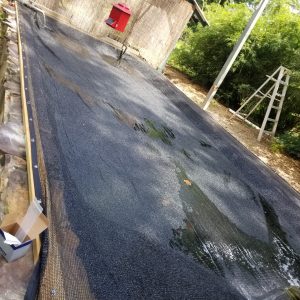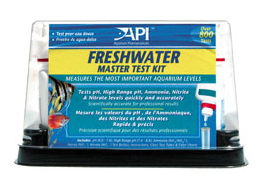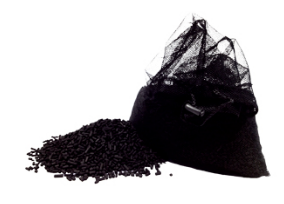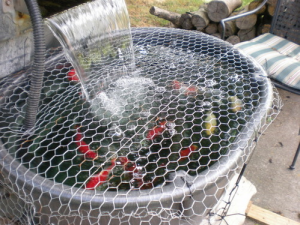Hurricanes can be incredibly destructive in both force and outcomes. There have been some in the recent past that no one would probably have thought possible.
As a koi keeper, the thought of limiting the amount of damage flooding or power outages is daunting. But it can be done.
If you have a koi pond and live in an area where hurricanes or tropical storms are a constant threat, there are some things that you need to consider.
Making the Grade
If you are in an area that traditionally receives a lot of rainfall, building on the higher area with a grade of 6-12 inches is something worth considering. It will help to divert rainwater away from the pond.
Overflow Drain
This can be a simple addition to a pond and is invaluable for when water levels rise (either through forgetfulness in filling the pond or when Mother Nature adds it).
Intentional Grounding
If you are around water and electricity, it’s a good idea not to scrimp on the protection. Use GFI outlets and heavy duty wiring. It’s not only good for storms but lightning strikes and wet weather.
Koi Stocking Density
Stick to the recommended number of koi that will keep your pond healthy. More koi means more waste. Bigger koi mean more waste. It can be tough to pass up that Ochiba that is on sale, but a pond that has a fish load that all of the supporting filtration can handle is more likely to be a healthier environment— especially when things get hairy.
When the forecasts start looking grim, there are steps to take and materials to gather that will go a long way in keeping your koi and your pond running.
Stop Feeding Your Koi
As much as five days before the storm is scheduled to hit, stop feeding your koi. A stressed fish (as they will be) will not put eating at the top of their survival list. They will head to the deepest part of the pond and wait it out.
All the uneaten food can add ammonia to your pond, especially as your filtration will more than likely be affected by power outages or increased contaminants. Your koi will be able to survive longer without food than without oxygen.
Secure Netting

There will be debris. There will be lots of debris. Fine mesh netting is the best option so that it stops a lot more debris from ever getting into your pond—and from your koi getting out. And it has to be anchored down! A lawn chair on each corner will not stop it from getting blown or washed away.
Veteran storm rider, Sandy Campbell, came up with this set up to make sure the top netting didn’t get washed away.
Sand Bags
A barrier around a ground level pond can help not only against flood water getting into the pond, but also to keep debris out.
Potential Debris Removal
Anything that has the potential to end up in your pond needs to be lashed or put somewhere where it can’t become an unwelcome addition to your koi’s home. If you can trim back some of your trees and bushes this can minimize debris getting into the pond and possibly puncturing the liner.
Water Change
Starting off with fresher water can help. Some enthusiasts recommend as much as a 50% water change leading up to the storm, however, 25% is more the norm. With larger ponds bigger than normal water changes can take a long time to replenish.
Filters
Give them a proper cleaning before the storm hits. Again, getting as close to spic n span at the beginning can help with the aftermath.
Water Levels
If you are expecting heavy rainfall and flooding, lowering the water level can be beneficial. With increased rainwater and runoff, some enthusiasts recommend adding baking soda to help stabilize the pH before the storm and rainwater hit.
Pump Off and Out
Consider turning off any pumps that take water from the pond’s bottom, too. If any of your plumbing is damaged in the storm it might pump all the water out.
Drainage and/or overflow systems will also need to be as clean as possible to help your pond more efficiently deal with any new debris.
If you have a filter pit, wait until the last minute and then remove the pumps so that they don’t flood.
Maintenance Essentials
Pipe Fixing Material
Depending on the severity of the storm, there may be one or two fixes needed to damaged pipes. Extra PVC pipe, couplings, fittings, and glue are some of the basics you will need.
 Test Kits
Test Kits
Make sure you stock up on the full panel of test kits. You will be using them frequently:
- Ammonia
- Nitrite
- kH
- pH
It is important to note that if you are using an ammonia binder, you will probably get a false positive result.
Chemicals
Baking soda
This is a quick way to help to raise the alkalinity in a situation where the pH crashes and the water becomes acidic. Here is an article about how rain water can affect a ponds chemistry. Some enthusiasts will add one cup per thousand gallons a day before the storm hits. Stabilizing the pH around 8 will help to keep the koi safe.
Pond Salt
This is untreated salt and can be found in most hardware and pond stores. It also goes by rock salt and solar salt. Adding 1lb per 100 gallons of salt to the pond (one time only) can help to reduce a stressed out pond population and improve the slime coat to help against parasites and bacteria.
Hydrogen Peroxide
Although a last line of defense, adding hydrogen peroxide to a severely oxygen-depleted pond can help to increase dissolved oxygen levels. ½-1 cup per 100 gallons is the normal amount.
Ammonia Binding Dechlorinator
There are dechlorinators that do just that—removing chlorine and chloramine from the water. The ammonia binders then take it a step further and attach to the ammonia, detoxifying it so that your biological filter does the rest naturally.
 Activated Charcoal
Activated Charcoal
If you have toxins that make their way into your pond from runoff or the rainwater itself, activated charcoal is a great way to neutralize them. It also helps with dissolved organics that might get into your pond.
Koi Clay (Calcium Bentonite)
This will help with the removal of positively charged free radicals and pond pollutants and add some essential trace minerals to the water that might not have any in it. But use it sparingly.
Alternative Power Supply
Generator
A good generator can be an important part of saving many of your koi’s lives after a big storm. Many koi owners that have gone through storms will attest to the philosophy that spending that little extra on a good generator will save a lot of head (and heart) aches down the road.
Make sure you have a good supply of gas available, too. You don’t know how long you may be out of power for, and gas prices have a tendency to spike after a major storm in those areas affected by the storm. If possible, keep it on the highest ground you have to prevent it being damaged in the event of flooding.
Inverter
Power inverters are a relatively inexpensive way to generate power. They can be plugged into car battery and help to provide anywhere from 300-750 watts. But remember, you will need to start your vehicle to keep its battery from being drained. Also, make sure the inverter has three pronged outlets.
Other impromptu Power Supplies that can also be used to convert DC to AC for inverters are marine batteries, self-starting mowers or motorcycle batteries.
UPS
If your power does go off, an Uninterruptible Power Supply (UPS) will provide power for a short period of time immediately after your power is lost.
Solar-powered Pond Oxygenators
These portable pumps can be quite handy for those times when your power is out. The smaller units don’t produce a large volume of pumped air, but can be handy in a pinch.
Battery-operated Bubble Boxes.
If power outage is a real concern (as it often is in big storms), aerating a pond can become a real issue. The battery-operated bubble boxes offer some relief if you have a fully stocked pond. These are typically added to bait boxes and can last up to 44hrs on two batteries.
Pond Stratification
Pond stratification is normal in ponds with thermal differences, resulting in two different levels of dissolved oxygen. The more oxygen rich water is on the top, while the lower density on the bottom. But in heavy storms with significant rainfall or flooding, the water column mixes which can dangerously lower the overall oxygen content. Having an aeration system bubbling from the bottom can help to keep the oxygen levels up.
Temporary Re-homing
 This is not an ideal situation for your koi, but if a Hurricane is expected to be catastrophic, it might be the best option for your koi. It also depends on how many koi you have and how far you will need to take them to ensure their safety.
This is not an ideal situation for your koi, but if a Hurricane is expected to be catastrophic, it might be the best option for your koi. It also depends on how many koi you have and how far you will need to take them to ensure their safety.
Also, you will have to worry about the environment and the water quality of the pond or facility they are going to. Both parties will also have concerns about contamination (disease, bacteria, parasites).
Bathtub Gin Rin
Depending on the size and number of your koi, you can use your bathtub as a temporary residence for Koi. Some people will do this for a short period of time before while they are updating an old pond or building new ponds.
Again, depending on the severity of the storm, it is a nice way to be able to keep them out of the elements. It is also close to a water supply for convenient water changes.
This will not be an ideal option if you have a bigger koi or many of them (ie a high fish load).
Stock Tanks, Kiddy Pools and Intex Pools.
Stock tanks can be extremely helpful in a pinch. Raising them up on cinder blocks is a great way to keep the tank above flood levels. But make sure they are covered—securely! Stressed koi will still jump.
Kiddy pools and intex pools are the same principle but will be a little less sturdy than the hard plastic stock tanks.
You can even make it more livable in these impromptu accommodations by adding a submersible pump. Frequent water changes or some activated bacteria and a filter mat can help to keep the conditions in the temporary home more koi friendly.
After The Storm
Water Quality
Test, test, and test again. Water quality is going to be of prime importance in helping your koi recover quickly.
Depending on whether or not your pond flooded, some enthusiasts recommend upwards of a 75% water change. However, 25-50% changes are ok if performed regularly and until water parameters approach normal again.
Koi Check
Some of your koi might not be readily visible as they could spend a bit of time at the bottom or the water could be too cloudy to get an accurate count. But do your best to identify as many as possible.
Drain and Bottom Clear
If you have a bottom drain, clear out any debris that might be blocking it. Get it back to doing what it does best. If vacuuming is how you clean the bottom, now is the time to break it out and clear the bottom.
Pipe Check
If your pumps were off as a result of power loss, when they are back on observe to make sure that your pipes and plumbing haven’t been damaged.
Backwash Filters
The beneficial bacteria in your filters will become anaerobic fairly quickly and this can cause problems when it releases toxic hydrogen sulfide into your pond water once you reactivate your filters. Clean them before pumping water back through them if you haven’t been able to oxygenate the bacteria.
Dechlorination and Charcoal
It is good to know what additives your city or municipality has in its water ahead of time. As you will be performing some extensive water changes, have some dechlorinator on hand.
Similarly, adding charcoal will go a long way in helping to remove dissolved organics and toxins that might have washed into your pond.
A little koi clay can help with the murkiness and add some minerals to the water, too.
Hurricanes can be devastating, and losing koi is always traumatic, but they need you to ensure their survival so remember that your safety is paramount.



Please do not advocate test strips. NOT reliable!
Fixed.